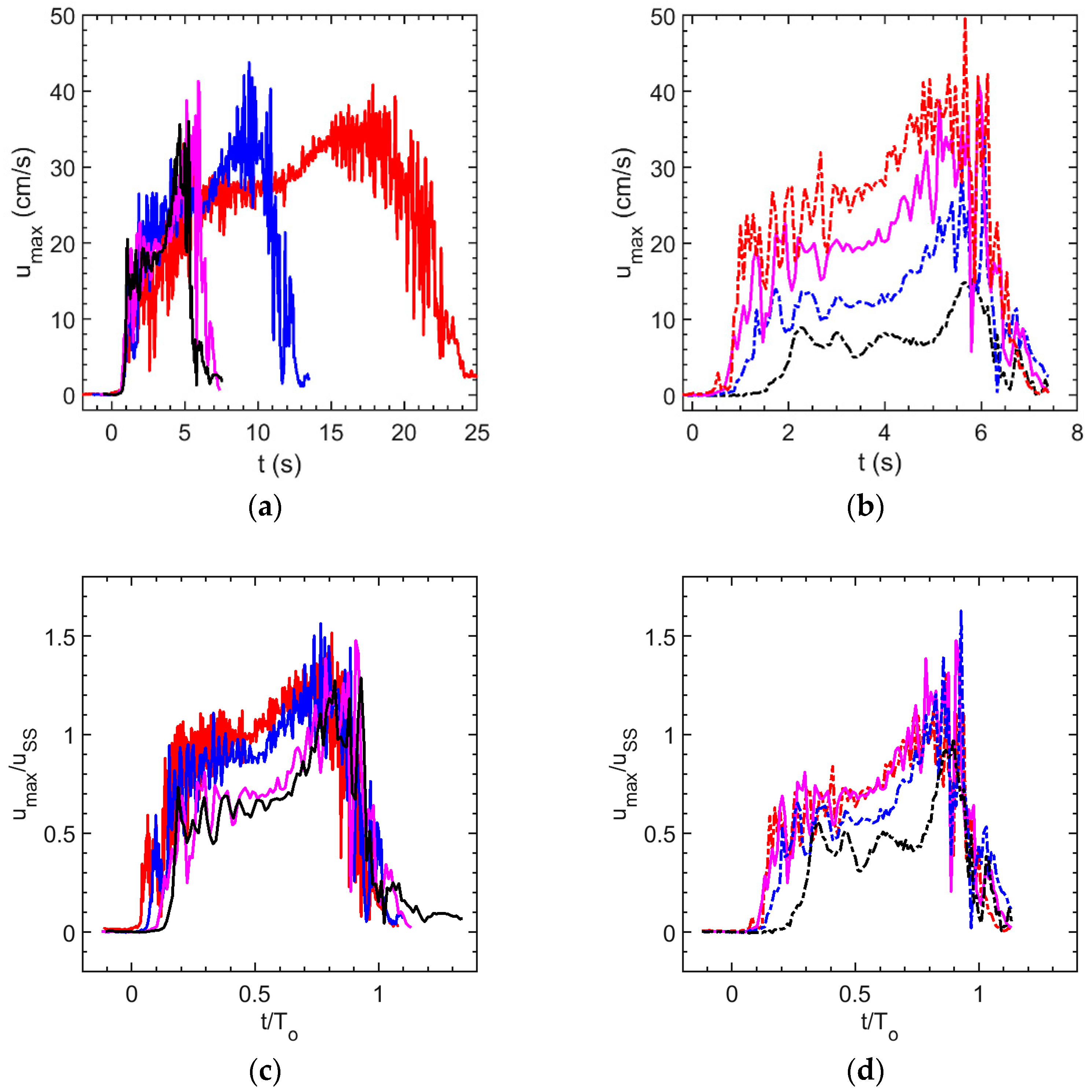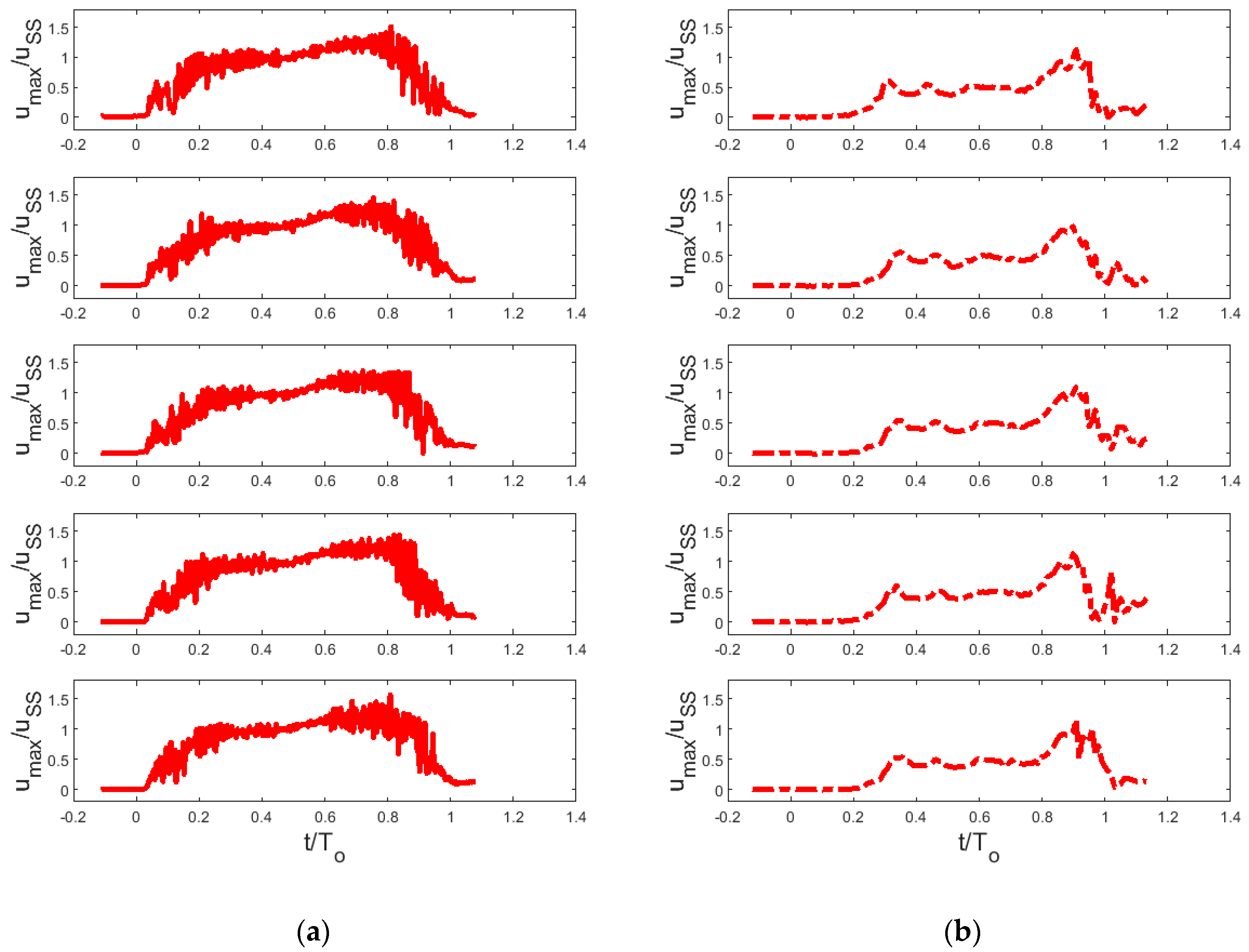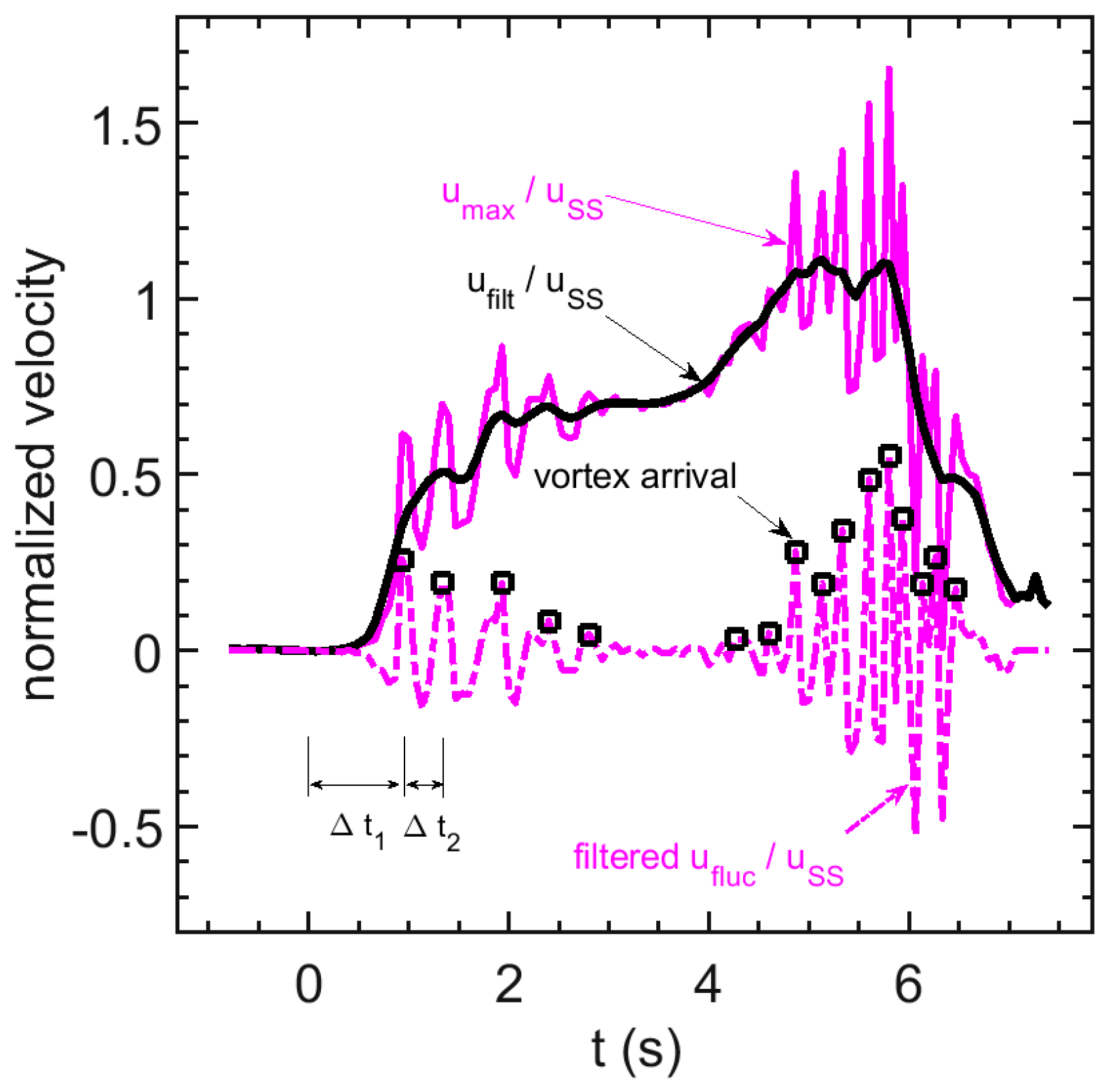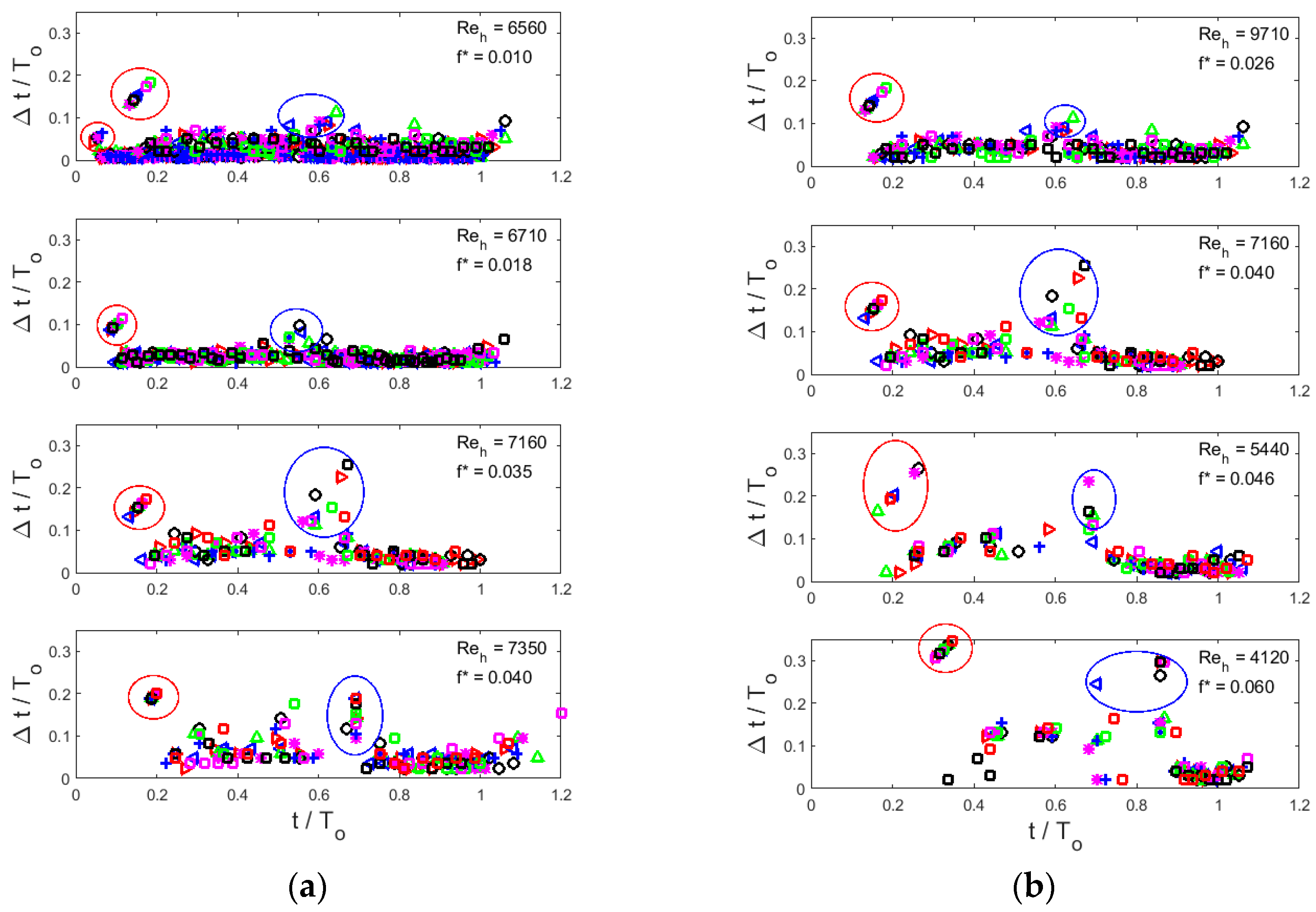Vortex Formation Times in the Glottal Jet, Measured in a Scaled-Up Model
Abstract
:1. Introduction
2. Materials and Methods
3. Results
3.1. Cases Studied
3.2. Exit Velocity Behavior
3.3. Calculating Jet Instability Vortex Formation Time
4. Discussion
Funding
Conflicts of Interest
References
- Krane, M.; Barry, M.; Wei, T. Unsteady behavior of flow in a scaled-up vocal folds model. J. Acoust. Soc. Am. 2007, 122, 3659–3670. [Google Scholar] [CrossRef] [PubMed]
- Krane, M.; Barry, M.; Wei, T. Dynamics of temporal variations in phonatory flow. J. Acoust. Soc. Am. 2010, 128, 3659–3670. [Google Scholar] [CrossRef] [PubMed]
- Titze, I. Principles of Voice Production; Prentice-Hall: Hoboken, NJ, USA, 1994; pp. 24–27. [Google Scholar]
- Krane, M. Aeroacoustic production of low-frequency unvoiced speech sounds. J. Acoust. Soc. Am. 2005, 118, 410–427. [Google Scholar] [CrossRef] [PubMed]
- Hermes, D.J. Synthesis of breathy vowels: Some research methods. Speech Commun. 1991, 10, 497–502. [Google Scholar] [CrossRef] [Green Version]
- Zhang, Z.; Mongeau, L. Broadband sound generation by confined pulsating jets in a mechanical model of the human larynx. J. Acoust. Soc. Am. 2006, 119, 3995–4005. [Google Scholar] [CrossRef] [PubMed]
- Coker, C.H.; Krane, M.H.; Reis, B.Y.; Kubli, R.A. Search for unexplored effects in speech production. Proc. Fourth Int. Conf. Spoken Lang. Process. 1996, 2, 1121–1124. [Google Scholar] [CrossRef]
- Hirschberg, A. Some fluid dynamic aspects of speech. Bull. Commun. Parlée 1992, 2, 7–30. [Google Scholar]
- McGowan, R. An aeroacoustic approach to phonation. J. Acoust. Soc. Am. 1988, 83, 696–704. [Google Scholar] [CrossRef]
- Zhang, Z.; Mongeau, L.; Frankel, S. Experimental verification of the quasi-steady approximation for aerodynamic sound generation by pulsating jets in tubes. J. Acoust. Soc. Am. 2002, 112, 1652–1663. [Google Scholar] [CrossRef]
- Howe, M. Contributions to the theory of aerodynamic sound, with application to excess jet noise and the theory of the flute. J. Fluid Mech. 1975, 71, 625–673. [Google Scholar] [CrossRef]
- Howe, M.S.; McGowan, R.S. Sound generated by aerodynamic sources near a deformable body, with application to voiced speech. J. Fluid Mech. 2007, 592, 367–392. [Google Scholar] [CrossRef]
- Howe, M.; McGowan, R. Production of sound by unsteady throttling of flow into a resonant cavity, with application to voiced speech. J. Fluid Mech. 2011, 672, 428. [Google Scholar] [CrossRef] [Green Version]
- Howe, M.; McGowan, R. Aerodynamic sound of a body in arbitrary, deformable motion, with application to phonation. J. Sound Vib. 2013, 332, 3909–3923. [Google Scholar] [CrossRef] [PubMed] [Green Version]
- McPhail, M.; Campo, E.; Krane, M. Aeroacoustic source characterization in a physical model of phonation. J. Acoust. Soc. Am. 2019, 146, 1230–1238. [Google Scholar] [CrossRef] [PubMed]
- Sherman, E.; Lambert, L.; White, B.; Krane, M.H.; Wei, T. Cycle-to-cycle flow variations in a square duct with a symmetrically oscillating constriction. Fluid Dyn. Res. 2019, 52, 015505. [Google Scholar] [CrossRef] [PubMed]
- Ringenberg, H.; Rogers, D.; Wei, N.; Krane, M.; Wei, T. Phase-averaged and cycle-to-cycle analysis of jet dynamics in a scaled up vocal-fold model. J. Fluid Mech. 2021, 918. [Google Scholar] [CrossRef] [PubMed]
- Howe, M. Theory of Vortex Sound (No. 33); Cambridge University Press: Cambridge, UK, 2003; pp. 115–118. [Google Scholar]
- Drechsel, J.; Thomson, S. Influence of supraglottal structures on the glottal jet exiting a two-layer synthetic, self-oscillating vocal fold model. J. Acoust. Soc. Am. 2008, 123, 4434–4445. [Google Scholar] [CrossRef] [Green Version]
- Pickup, B.; Thomson, S. Influence of asymmetric stiffness on the structural and aerodynamic response of synthetic vocal fold models. J. Biomech. 2009, 42, 2219–2225. [Google Scholar] [CrossRef] [Green Version]
- Triep, M.; Brücker, C.; Schröder, W. High-speed PIV measurements of the flow downstream of a dynamic mechanical model of the human vocal folds. Exp. Fluids 2005, 39, 232–245. [Google Scholar] [CrossRef]
- Erath, B.; Plesniak, M. An investigation of jet trajectory in flow through scaled vocal fold models with asymmetric glottal passages. Exp. Fluids 2006, 41, 735–748. [Google Scholar] [CrossRef]
- Chang, M.D.; Chen, J.H.; Tsai, C.G.; Hsiao, T.Y.; Shao, Y.H. PIV analysis of ultrasound images of vocal fold vibration. J. Biomech. 2007, 40, S227. [Google Scholar] [CrossRef]
- Oren, L.; Khosla, S.; Gutmark, E. Effect of vocal fold asymmetries on glottal flow. Laryngoscope 2016, 126, 2534–2538. [Google Scholar] [CrossRef] [PubMed]
- Khosla, S.; Murugappan, S.; Gutmark, E. What can vortices tell us about vocal fold vibration and voice production. Curr. Opin. Otolaryngol. Head Neck Surg. 2008, 16, 183–187. [Google Scholar] [CrossRef] [PubMed]
- Horáček, J.; Uruba, V.; Radolf, V.; Veselý, J.; Bula, V. Airflow visualization in a model of human glottis near the self-oscillating vocal folds model. Appl. Comput. Mech. 2011, 5, 21–28. [Google Scholar]
- Šidlof, P.; Doaré, O.; Cadot, O.; Chaigne, A.; Horáček, J. PIV Measurements of Velocity Fields in Glottis on a Physical Vocal Fold Model. In Proceedings of the Fifth International Workshop on Models and Analysis of Vocal Emissions for Biomedical Applications, Firenze, Italy, 13–15 December 2007. [Google Scholar]
- Šidlof, P.; Doaré, O.; Cadot, O.; Chaigne, A. Measurement of flow separation in a human vocal folds model. Exp. Fluids 2011, 51, 123–136. [Google Scholar] [CrossRef] [Green Version]
- Krane, M.; Sinder, D.; Flanagan, J. Aeroacoustic modeling of speech sound production. In Proceedings of the 5th Seminar on Speech Production: Models and Data, Seeon-Seebruck, Bavaria, Germany, 1–4 May 2000; pp. 177–180. [Google Scholar]





| uSS (cm/s) | To (s) | hmax (cm) | f* | Reh | N | flife (Hz) |
|---|---|---|---|---|---|---|
| 28 | 23.7 | 2.34 | 0.010 | 6600 | 7 | 32 |
| 28 | 12.3 | 2.40 | 0.018 | 6700 | 10 | 61 |
| 28 | 6.53 | 2.56 | 0.035 | 7200 | 10 | 115 |
| 28 | 5.67 | 2.62 | 0.040 | 7300 | 10 | 132 |
| 16.1 | 6.53 | 2.56 | 0.060 | 4100 | 10 | 115 |
| 21.3 | 6.53 | 2.56 | 0.046 | 5400 | 10 | 115 |
| 38 | 6.53 | 2.56 | 0.026 | 9700 | 10 | 115 |
Publisher’s Note: MDPI stays neutral with regard to jurisdictional claims in published maps and institutional affiliations. |
© 2021 by the author. Licensee MDPI, Basel, Switzerland. This article is an open access article distributed under the terms and conditions of the Creative Commons Attribution (CC BY) license (https://creativecommons.org/licenses/by/4.0/).
Share and Cite
Krane, M. Vortex Formation Times in the Glottal Jet, Measured in a Scaled-Up Model. Fluids 2021, 6, 412. https://doi.org/10.3390/fluids6110412
Krane M. Vortex Formation Times in the Glottal Jet, Measured in a Scaled-Up Model. Fluids. 2021; 6(11):412. https://doi.org/10.3390/fluids6110412
Chicago/Turabian StyleKrane, Michael. 2021. "Vortex Formation Times in the Glottal Jet, Measured in a Scaled-Up Model" Fluids 6, no. 11: 412. https://doi.org/10.3390/fluids6110412
APA StyleKrane, M. (2021). Vortex Formation Times in the Glottal Jet, Measured in a Scaled-Up Model. Fluids, 6(11), 412. https://doi.org/10.3390/fluids6110412





